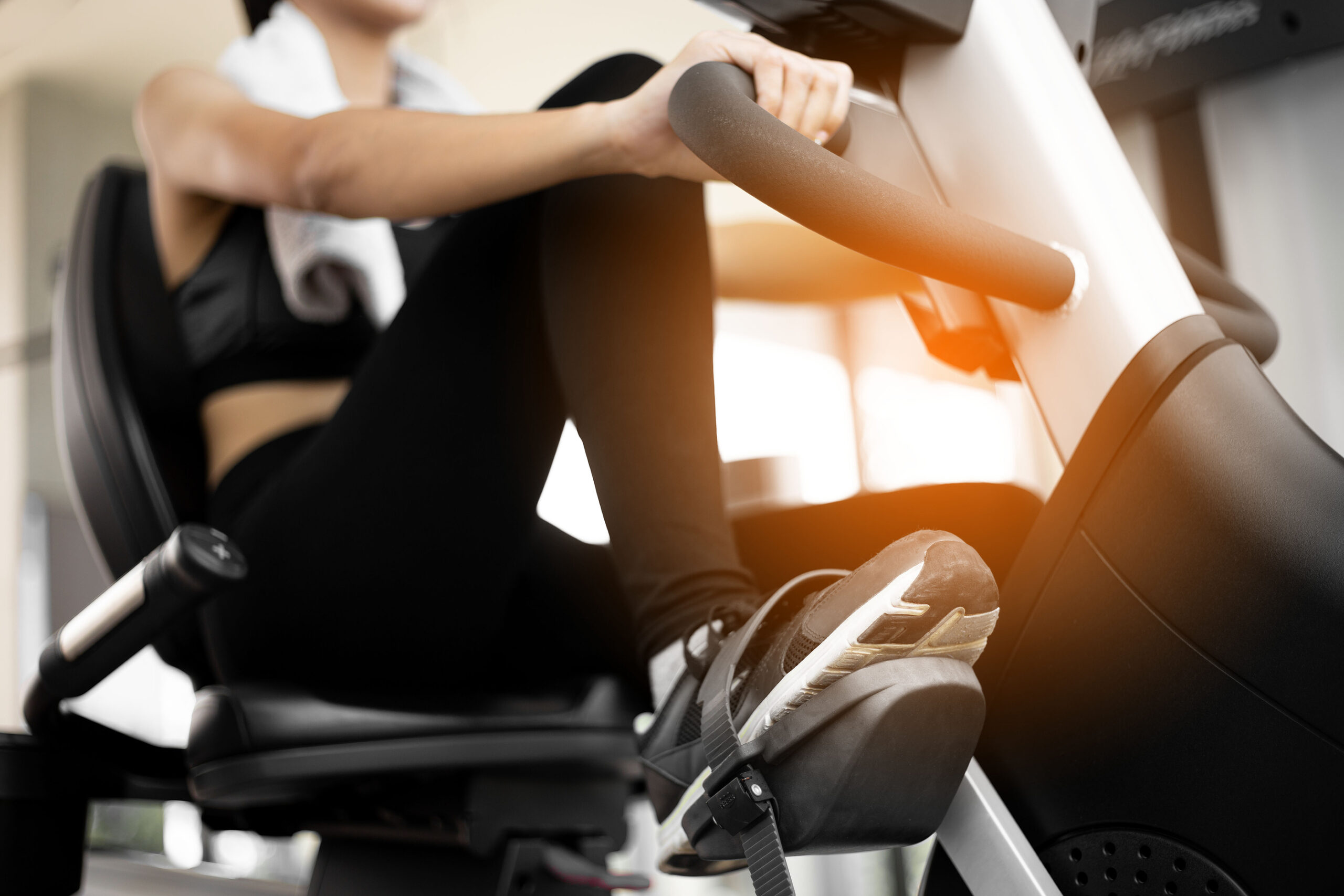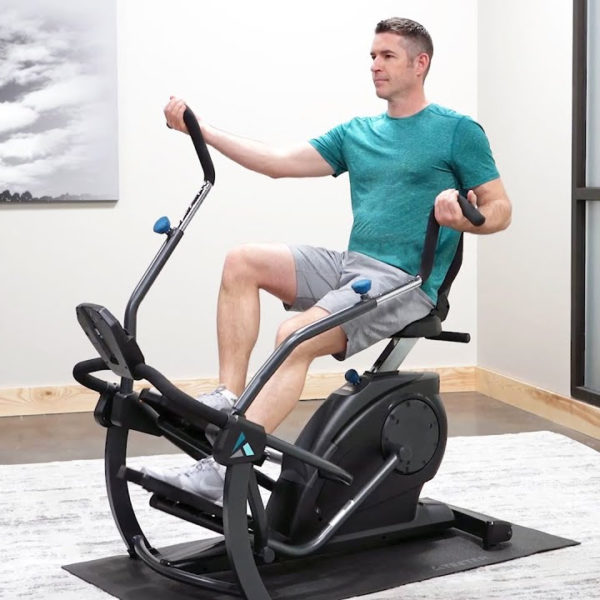When it comes to affordable recumbent cross trainers, Teeter’s FreeStep LT3 is one of the top options currently on the market.
For starters, it’s a true cross trainer and not just a lightweight recumbent bike with arms attached – which is rare in this price range.
But as affordable cross trainers go, it’s got a lot to offer – the most notable of which is a smooth, comfortable pedaling motion.
Other highlights include a 15 lb flywheel, 13 levels of magnetic resistance, a solid frame, and an adjustable angle backrest.
The biggest downside I see is found in the warranty department, it could be longer, but I think the benefits definitely outweigh the cons here.
But I’m getting a little ahead of myself.
In this review, I’ll be going over everything this recumbent cross trainer does and doesn’t have going for it; I’ll also try to compare it to other comps to see how it stacks up against the competition.
After reading, you’ll know whether or not the Teeter FreeStep LT3 is the right choice for your home.
Let’s begin.
The Teeter FreeStep LT3 Recumbent Cross Trainer
Ok, so I know the LT3 isn’t technically a bike, so I feel a little wrong for talking about it on this site, but it’s very similar to a recumbent bike, so I hope you forgive me.
Plus, I recently did an article comparing recumbent bikes to recumbent trainers and it got me thinking about these devices.
Feel free to check out the full article, but I’m going to summarize the biggest difference right now – recumbent trainers use a stepping pedal motion and they come with moving handlebars.
Otherwise, they’re pretty identical.
But the stepping motion of the pedals makes them even lower-impact than recumbent bikes, making recumbent trainers a great choice for the elderly or anyone else dealing with achy joints.
As far as I know, Nu-Step gave us the first recumbent cross trainers and they’re still the top brand when it comes to these machines today.
You’ll find Nu-Steps in most rehab facilities, assisted living facilities, and even commercial gyms and they do offer a home lineup – but they’re pretty darn expensive.
Teeter is one of the only brands I’m aware of that offers a significantly more affordable trainer – technically, they offer two.
The LT3 we’re here to discuss now is their highest-end model to date, but they also have the entry-level LT1 (there are subtle differences between ’em, mostly in the comfort department).
Anyway, let’s get rolling with the LT3 and see what it has to offer.
Pros
- Low-impact
- 15 lb flywheel
- 13 levels of magnetic resistance
- Pretty heavy-duty frame
- 300 lb weight limit
- Adjustable angle backrest
- Adjustable handles
- Access to free fitness app
- Price fairly
Cons
- Frame warranty could be longer
- Console very basic
Resistance
The pedaling motion on the LT3 is very true to the classic cross trainer pattern that mimics a stepper more than anything else.
This lack of rotation tends to a more comfortable movement for achy knees and hips, allowing most folks to comfortably use these devices.
But even though the pedaling motion is different, you’ll notice that the pedals are still attached to a rotating flywheel in the rear of the frame.
This means the LT3’s resistance is created in much the same way it is for most home recumbent bikes – with a rotating flywheel and a magnetic system.
So, I think it makes sense to consider the weight of the flywheel here just like we would with any other exercise bike.
The LT3 comes with a 15.4 lb flywheel (7 kg), which isn’t massive by any means, but it’s still pretty good when compared to other similarly priced recumbent bikes.
For example, Sole’s R92 is packing a little more height with a 20 lb flywheel, but Nautilus’ R618 is only packing a 13 lb flywheel.
So, at 15 lb, I think the LT3 is doing just fine.
This flywheel is heavy enough to provide a smooth pedaling motion, but not necessarily heavy enough to provide a ton of resistance.
I’m not sure this is the best piece of equipment for HIIT workouts, but when it comes to gentle, low-impact range of motion, it’s well-equipped.
Speaking of which, the LT3 comes with 13 resistance levels that are adjusted by turning a knob on the side of the seat.
Some users have mentioned that it’s pretty easy to reach and turn during workouts, but it’s location can make it a little tough to see which level you’re on while using.
But most folks are pleased with the range of resistances it offers and report it provides ample resistance for a decent workout.
Overall, I think the LT3 scores highly in this department. I like that it comes with a pretty heavy flywheel and 13 resistance levels gives you a nice range of intensities to work with.
Frame
The LT3 takes up a footprint of roughly 55″ x 38″, making it quite a bit wider than most recumbent bikes, but also a bit shorter.
More importantly though, I like to look at the assembled weight and weight capacity because I feel these specs give us a better idea as to how “heavy-duty” we can expect the trainer to fee.
And seeing higher numbers in both cases is a good thing in my book.
The LT3 comes with an assembled weight of 110 lb, which is just a few pounds more than the R618 mentioned above (and about 20 lb less than the R92).
It’s also pretty identical to the assembled weight on the similarly priced ProForm Pro C10R.
So, it terms of weight, it stands up pretty well to other recumbent bikes in its price range.
As I mentioned in the intro, there aren’t a lot of recumbent cross trainers in this price range to compare the LT3 to, although as I’m writing this I did find XTERRA’s RSX1500, which is just about $100 more than the LT3 (at the time of writing this anyway).
It comes with an assembled weight of 132 lb, so it’s a little heavier-duty than the LT3 (we’ll discuss the RSX1500 a little more down below).
The LT3 also comes with a weight limit of 300 lb, which is pretty good for any quality home cardio machine, allowing most folks to safely access this machine.
And according to Teeter, the LT3 should comfortably fit most folks between 4’11” – 6’6″ tall.
Overall, I think the LT3 scores pretty highly in the frame department too. It isn’t the heaviest-duty trainer on the market, but it isn’t a lightweight, flimsy product either.
And most users agree it provides a stable base to exercise on.
Warranty
Teeter covers their FreeStep LT3 Recumbent Cross Trainer with the following home warranty:
- 2 year all-inclusive
Ok, this means Teeter covers the frame, all parts, and all labor for any malfunction that might occur in the first 2 years.
This warranty isn’t bad for an exercise machine in this price range, but it would be nice to see a separate, longer frame guarantee spelled out.
But the frame is usually the least likely thing to malfunction, so there’s that.
2 years on parts and labor is actually pretty good.
For the sake of comparison though, I do want to mention that XTERRA offers a lifetime frame and 3 years parts guarantee on that RSX1500 mentioned above.
Overall, I think there’s room for improvement in Teeter’s warranty, but it isn’t awful by any means.
Oh, Teeter also offers a 60 day grace period for you to try their FreeSteps out and send ’em back for a full refund (minus shipping) if you don’t like ’em… that’s a pretty sweet deal.
Features
The Teeter FreeStep LT3 comes with the following features:
LCD console- the console on this machine is small and simple, no fancy thrills here. It really only displays time, distance, speed, and calories and it isn’t backlit, so you’ll want to use it in a well-lit room for optimal viewing.
Adjustable handlebars- you can adjust the length of your handlebars for optimal comfort, but you can also rotate them to change the grip options to help you target different upper body muscles.
Adjustable seat- you can adjust the height of the seat, but you can also adjust the angle of the backrest for a more customized fit.
Media tray- there’s a small tray where you can place a tablet or smart phone in case you want to watch Netflix during workouts.
Free app- you can also use your phone/tablet to access TeeterMove, Teeter’s free fitness app where you can follow along with instructor-led workouts (it’s refreshing to see a free app, not many of those these days).
Water bottle holder- and finally, there’s a place to put your water bottle for easy hydration.
Cost
At the time of writing this review, the LT3 is going for $999 on Teeter’s website.
You can also find this machine on Amazon and other retailers, so it’s worth comparing prices, but as I’m writing this, Teeter has the most affordable price.
As I’ve mentioned a few times already, there aren’t many true recumbent cross trainers in the $1k price range.
There are several really affordable “recumbent trainers” in the $300 – $400 price range, but most of these use a circular pedaling motion – meaning they just took a recumbent bike and put handles on it.
Most of the real recumbent trainers we see cost a lot more.
Nu-Step’s entry-level T4r starts at around $4500, so certainly not in the same league as the LT3.
There are other more affordable quality trainers, but again, most of them start at around $2k.
But XTERRA’s RSX1500 is a great comp because it’s a true recumbent trainer and it costs $1099 (through XTERRA directly, might be cheaper through other sites), making it just a little more expensive than the LT3.
The RSX1500 comes with a 22 lb flywheel, 24 levels of magnetic resistance, a larger, nicer console, 25 built-in workout programs, a heavier-duty frame, and a longer warranty.
Plus, XTERRA is a good budget brand in its own right (they’re owned by the same company that owns Sole and Spirit).
Final Thoughts
Well, that about does it for the LT3.
I don’t have much to complain about here.
I think Teeter’s LT3 is a nice product that fills a necessary need, giving folks affordable access to the wonderful piece of equipment that is the recumbent cross trainer.
The LT3 scores pretty highly in terms of performance and it’s well-reviewed by most of its users.
The frame warranty could be longer and the console is really basic, but otherwise I think it’s a great option for people looking for an affordable, low-impact fitness machine.
But then there’s XTERRA’s RSX1500, which is sporting more impressive numbers in every category, is heavier-duty, and is even backed by a better warranty.
I like Teeter and I think they have a great product in the LT3, but if I had to decide right now, I’d have a hard time choosing it over the RSX1500.






